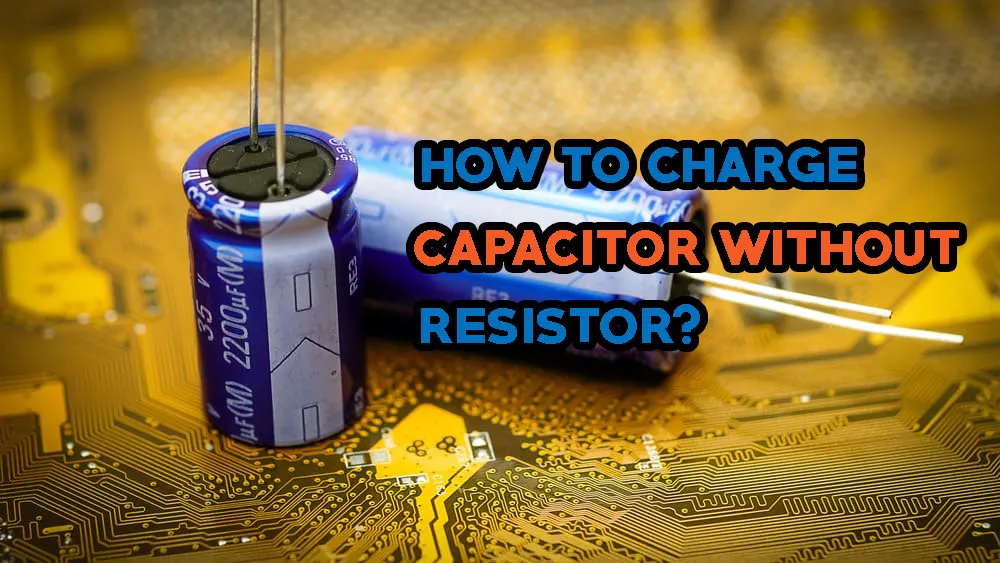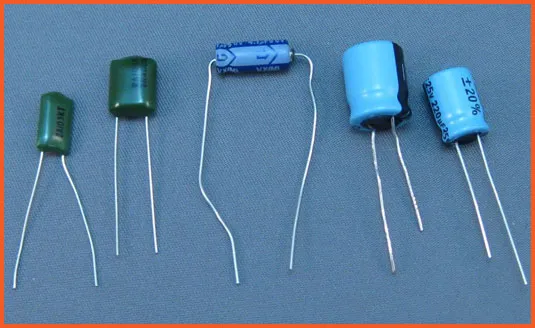How to Charge Capacitor Without Resistor?

How to Charge Capacitor Without Resistor
It is essential to understand how capacitors work when working with them. Condensers are often a source of confusion, particularly to those who are new to the subject.
Are you thinking How to Charge Capacitor without Resistor? Your electronic project will benefit from this task, as well as learn more about capacitors at the same time. There's no need to worry! In this article, I am going to share the method with you which you can use without the help of the resistor. So if you are interested in it, then stick with us till the end of the article!
What is a Capacitor?

What is Capacitor?
Electric fields can be stored in capacitors as electrical energy. An insulating material called dielectric separates two conductors (usually metal plates). An electric potential difference between two plates occurs when a voltage is applied to a capacitor.
Capacitor Role
There are many electronic circuits that rely on capacitors. The output of a rectifier is smoothed using it in power supplies. As well as being used as a signal filter, it also removes unwanted frequencies.
The duration of electrical signals is also controlled by capacitors in timing circuits. A radio, television, or computer can't function without this component. Voltage fluctuations are also smoothed with it in electricity systems.
How to Charge Capacitor Without Resistor
Connecting the power source
You must connect the power source to the capacitor before you can charge it. Install the capacitor according to your installation manual after unplugging the fuse connected to the battery. A wire should be connected to either of the capacitor terminals, and the battery's positive terminal should be connected to the other wire.
Connect the load
You can charge a capacitor with a test light without a resistor in the simplest and most effective way. One end of the wire needs to be connected to the capacitor's remaining terminal and another end to the test light's terminal.
Battery connection to load
The remaining terminal of your test light needs to be connected with another wire. Using the negative end of the battery as a connection point, connect the other end of the wire to the battery. It's convenient to hold everything together with alligator clips and battery holders.
Set the multimeter
A multimeter will be required next in order to measure the voltage. The charge level (voltage) of the capacitor can be tested with a multimeter during or after charging. The capacitor needs to be connected to the multimeter with extra wiring for this setup.
Charging the capacitor
It will start to emit some light once everything has been connected, charging the capacitor as it does so. Multimeter readings should be observed. Batteries should read roughly the same voltage as capacitors. The capacitor will only be charged to its 12V capacity if it is connected to a 12V car battery. This means that the capacitor is ready to be used once the bulb dims or goes out.
How Long to Charge?
There are a range of factors that influence how long it takes to charge a capacitor without a resistor. When compared to a capacitor with a relatively small capacity, a large capacitor will take longer to fully charge. Capacitors usually charge completely within 5 minutes.
Capacitors need a resistor to be charged. Why?
Electric charge is stored by capacitors, which are passive electronic components. One terminal is positive, the other negative, and they are referred to as the plates. When an external voltage exists between two plates, the polarity of each determines the amount of current that can flow.
By dropping its value exponentially as more power flows through it, a resistor limits this current without limiting the charging rate. Electrical pressure is used in this manner to ensure that neither side is overheated. You will be limited to what kind of capacitors you can use if you don't use a resistor with your capacitor, whether it's a small one like 0.22uF or a large one like 100uF.
Can we charge a Capacitor with a Battery?
AC power supplies can be used to charge capacitors without using resistors. Since DC current has no frequency, therefore there is no alternating flow of electrons, if you just use the battery to charge the capacitor, it will take longer for the capacitor to charge. A DC signal adds another layer of complexity. Inductors and capacitors are connected together and oscillate. They are therefore suitable for low- and high-frequency applications.
DC can charge capacitors?
Direct current (DC) can charge a capacitor. While the DC voltage does not discharge the capacitor, it is similar to charging with AC voltage.
DC voltage can be applied to a capacitor by connecting its positive terminal to its positive lead. Positively connected to the capacitor's negative lead, and negatively connected to the voltage source's negative terminal. You may damage your capacitor if you don't maintain the correct polarity when using a battery.
The desired voltage can be reached by flowing current for a few minutes once the power source is connected. The capacitor will remain charged even after you disconnect the power source.
Faqs
Question 1: Are capacitors capable of working without resistors?
Answer: You will not need a resistor in series if your capacitor's ESR and output impedance give you a charging current that is acceptable. Since these quantities don't typically have minimum values, it might be best to have one anyway.
Question 2: A capacitor can be charged using what kind of resistor?
Answer: Unless otherwise specified, your capacitor will require a 1-watt, 30-1000 ohm (1kohm) resistor to be charged. Charge the capacitor slowly by using a resistor with a higher impedance.
Question 3: Can a capacitor charge without current?
Answer: The charge of capacitors cannot be changed without a current flowing. Electrons are constantly moving from one point to another while they are in a current. In a given space, the charge is determined by how many electrons there are. Charges can be changed by moving electrons, or by flowing currents.
Final Thoughts
If you don't know how to charge Capacitor without Resistor, then let me tell you that there is no need to use a resistor when charging a capacitor. To accomplish this, you might want to use a light bulb or a battery. If you are concerned about overcharging your capacitors, you should use a resistor. Voltage and current must also be closely monitored. If too much current is applied for too long, a capacitor will explode and become unusable.
Related Articles
How Long Do Electrolytic Capacitors Last
How to Charge Capacitor Without Resistor?
What is the Standard Lead Spacing for Capacitors?
What Is CBB61 Capacitor - Function and Applications
What Causes Capacitors to Fail
Tantalum vs Ceramic Capacitor: What's the Differences?
Run Capacitor vs Start Capacitor
Radial vs Axial Capacitor: Whats the Differences?
Polyester vs Polypropylene Capacitors: Explained
Polarized vs Non-Polarized Capacitor
How to Install a Capacitor to Two Amps
How to Test a Hard Start Capacitor [Complete Guide]










